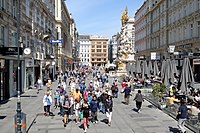
Photo from wikipedia
Abstract Urbanization and automobile-oriented development have resulted in a significant increase in vehicular trips towards central business district (CBD) areas, consequently increasing the demand for on-street parking. In many Indian… Click to show full abstract
Abstract Urbanization and automobile-oriented development have resulted in a significant increase in vehicular trips towards central business district (CBD) areas, consequently increasing the demand for on-street parking. In many Indian cities, on-street parking demand is regulated by an odd–even date on-street parking scheme. Under this scheme, sidewalks are subjected to fully and partially confined boundaries, affecting pedestrian movement and the level of service (LOS). Therefore, it becomes imperative to study the influence of on-street parking on pedestrian characteristics to design efficient pedestrian facilities. Pedestrian flow data were collected at three study sites in the CBD areas of three major metropolitan cities of Gujarat, India, using a videography technique. Investigation revealed an 18% reduction in walking speed for parking sidewalk face (PSF) compared to non-parking sidewalk face (NPSF), attributed to the variation in density and presence of parked vehicles. The influence of parked vehicles probed for a similar set of pedestrian densities revealed a 14% reduction in walking speed for PSF compared to NPSF. For the same geometric attributes of the sidewalk, PSF had a deteriorated pedestrian LOS at a given average condition, promulgating the need to develop separate LOS thresholds for PSF and NPSF. Based on the developed speed-density relationships for PSF and NPSF, the Monte-Carlo simulation was performed to facilitate the development of LOS thresholds. Based on the developed LOS thresholds and cumulative percentile plots, the study recommends LOS B as the design service level for sidewalks in the CBD area characterized by on-street parking.
Journal Title: Case studies on transport policy
Year Published: 2021
Link to full text (if available)
Share on Social Media: Sign Up to like & get
recommendations!